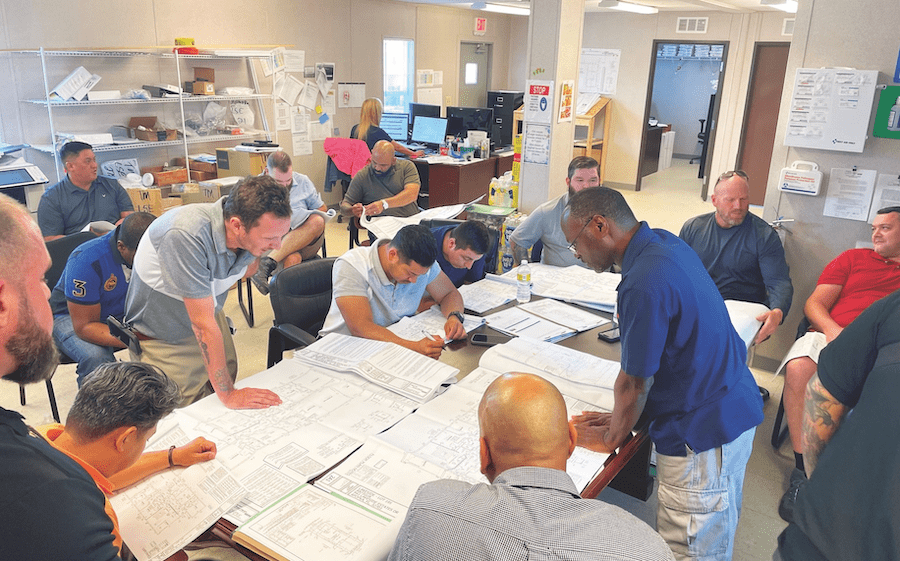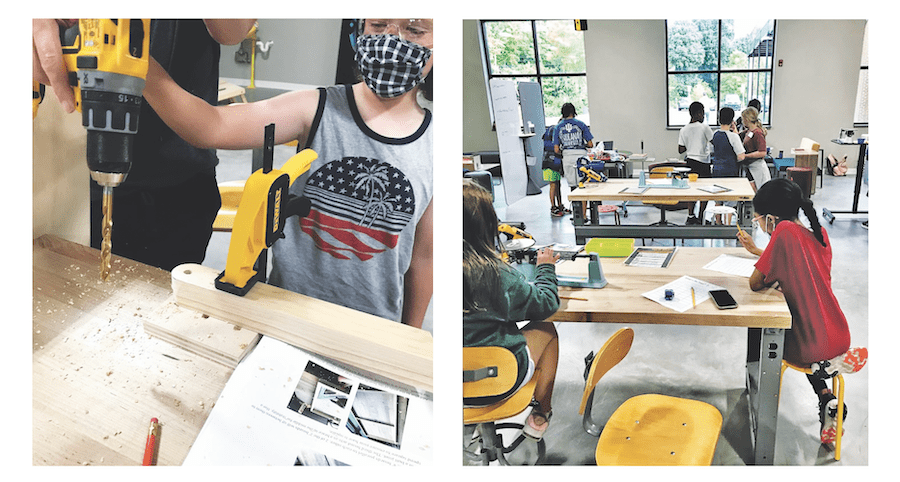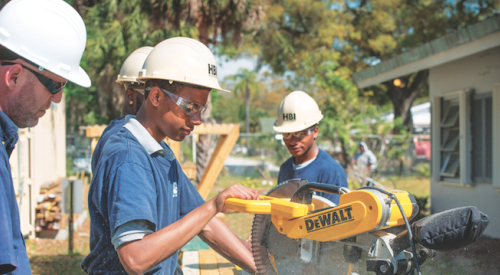When Branka Minic became CEO of the Building Talent Foundation (BTF), an Orlando, Fla.-based organization dedicated to addressing the construction worker shortage, she wondered about the root causes of the housing industry’s skilled worker shortage. What Minic found was a weak talent pipeline, a disconnect between what schools teach and what employers need, and way too much employee churn.
Funded in large part by the 20-member Leading Builders of America consortium, BTF has placed more than 1,000 candidates into construction-related jobs since Minic took the helm in 2019, and currently works with more than 500 employers and is active in 8 states. It plans to add 10 more markets within the next 12 months.
BTF is one of several, increasingly successful efforts to bring more (and ideally younger) workers onto jobsites and into construction-related career paths, encompassing other non-government organizations (NGOs), the National Association of Home Builders’ Home Builders Institute (HBI), state and local home builder associations (HBAs), private groups, and even individual home builders.
But the task is monumental. Based on data from the Bureau of Labor Statistics analyzed by NAHB Economics, the construction industry as a whole needs a net gain of about 2.4 million workers by 2025 to meet demand, a decent chunk of that for housing production.
With that, HBI’s 2022 Homebuilding Engagement Study found that 35% of the residential construction workforce was thinking of quitting their current jobs, and that half of those were considering leaving the field altogether.
RELATED
- Housing’s Great Rethink: Workforce Development Takes Center Stage
- After Recruiting and Hiring, Put in the Work to Keep Employees
- How to Scale Hiring and Create a More Diverse Workforce in Construction
Why? A lack of career advancement, followed by benefits and pay. More than 40% of survey respondents with 1-5 years’ experience were thinking of getting another job, and smaller-volume builders were more susceptible to turnover.
Meanwhile, Pro Builder’s 2023 Housing Forecast Survey found builders are relying on a wide range of sources to help refill the labor pool, putting themselves at the top of the list and followed closely by state or local HBAs, independent recruiting services or programs, trade partners, and local labor unions, in that order.
Builders Take the Lead in Training and Job Placement
Turning Leaf Construction, a Sanford, Fla.-based company that builds four to six custom homes per year, expects to hire six employees this year, and to perhaps double that number next year. To attract applicants, Turning Leaf recently raised its entry-level compensation to $17 per hour. And on Aug. 1, the company started offering a group health care plan to its employees.
John Riddle, Turning Leaf’s VP and business development manager, says his company upped the ante after attending job fairs for trade students and being told they could make more working at McDonald’s. Since sweetening its compensation, Turning Leaf advertised for a senior project manager and got eight qualified candidates.
Longer-term, Riddle says he and his business partner also have gotten more involved with their local HBA to present to trade-school students about the industry’s virtues.
Last year, Arizona-based Taylor Morrison launched Voyager, an immersive six-week, paid superintendent training program that, through June 2022, had trained 21 people. With active programs in Sarasota, Fla., and Atlanta, Taylor Morrison plans to expand Voyager nationwide.

To find trainees for the program, the builder has been working with Texas-based Proteus Recruiting Group, which places military veterans into civilian jobs. The vets are typically in their 20s or 30s, all attained a sergeant-level rank or above, and some had medical discharges. “They’re all smart and very focused,” says Steven Evans, senior national training partner for Taylor Morrison, in Punta Gorda, Fla.
The trainees are employees of the builder “from day one,” Evans says, and their training regimen includes crew management, understanding the company culture, classroom and field instruction, and safety.
“The No. 1 lesson we’ve learned is that training is meaningless unless the students have a job outlet,” says Scott Thorson, COO of Denver-based Oakwood Homes. In 2017 Oakwood opened the Colorado Home Building Academy, which initially trained supers but then realized there was a greater need for training carpenters and electricians. Oakwood then teamed with HBI and Franchise for Good, a nonprofit that helps other nonprofit businesses scale up and grow via a franchise model, to expand the academy format to other markets and trades, including plumbing. Those training centers have been rebranded as BuildStrong Academy, with chapters in Orlando, Fla., and New Orleans, with a goal this year to train 500 carpenters and a total of 750 tradespeople.
In 2023, the Colorado academy plans to move into the Community College of Aurora’s new Center for STEM, Power Mechanics and Applied Technologies, and BuildStrong Academy wants to place its training-to-placement model in 20 more cities by 2037, with plans to open in Charlotte, N.C., Houston, and Phoenix by 2024.
“We’re not backing down from the worker shortage challenge,” says Thorson, and that includes changing students’ negative impressions of the construction industry before they get into high school.
Home Builders Associations Reach Out to Young Workers
There’s little dispute that the industry is redoubling its efforts to bring more younger workers into its fold. And those efforts usually start with disseminating a message of opportunity through schools.
Since 2019, the Home Builders Association of Greater Des Moines, Iowa, has conducted a program called Build My Future, which exposes elementary and high school students to hands-on training in manufacturing, heavy equipment, welding, and other trade skills.
Working with HBAs in Cedar Rapids, Davenport, and Sioux City, Build My Future hosts four events per year, with slightly different targets. For example, the recent Cedar Rapids event attracted 500 middle schoolers, while Davenport’s drew about 400 8th graders. All told, more than 10,000 students have come through Build My Future since its launch, says Brandon Patterson, who oversees workforce development for the Greater Des Moines HBA.
The local chapter also raised at least $1.4 million to open a Skilled Trades Academy within the Des Moines public school system, which enrolled more than 400 students in its latest class. The academy teaches welding, carpentry, HVAC, plumbing, electrical, and painting. The HBA contributed another $600,000 to fund some of the academy’s teaching and counseling staff. “Urban students don’t have much access to shop classes anymore, so they are learning and doing something they’ve never done before,” Patterson says.

In 2015, the Colorado Springs (Colo.) Housing & Building Association started a program called Careers in Construction Colorado (CICC), which became a separate nonprofit entity four years later. The program now operates out of 47 state high schools with more than 1,600 students enrolled. Students who complete the course receive certificates that are recognized by the Department of Labor. In its first seven years, this program placed 626 students in construction-related jobs, and this year expects to place another 260. Its goal for 2025 is to have the program offered in 65 schools, with 5,000 students enrolled, and 20% of those earning certificates placed in construction jobs.
The association also conducts a Home Build program, which began in 2018 and has students build a modular house each year. Participating schools pay for the instructors and provide the classrooms as well as the construction jobsite. The program provides a $2,500 to $10,000 stipend for teachers.
“We are facilitators,” says Renee Zentz, CEO of CICC and of the Colorado Springs HBA. She adds that CICC’s program uses HBI’s 14-module curriculum, whose core is heavy on carpentry, tool use, and safety, with subsequent semesters devoted to specialized trade skills. She says there have been discussions with HBI to take this program nationwide. (Zentz also sits on BuildStrong Academy’s board.)
Getting Past Misconceptions About Jobs in Construction
When asked about the construction industry’s labor shortage, Zentz observes that, until recently, the industry has been “absent” when it comes to raising awareness among younger people. “But you have to start somewhere,” she points out, noting that CICC’s programs are “intentional, and we’re bringing the industry to the schools.”
Such efforts may help break down what builders and trade groups say has been resistance among school guidance counselors and administrators to pointing students toward careers in construction.
In Dallas-Fort Worth, the country’s largest housing market in annual starts and closings, labor availability has been a challenge over the last six or seven years, says Phil Crone, executive director of the Dallas Builders Association. He estimates that the market’s construction activity could absorb another 20,000 workers. “Our problem has been a lack of interest in the trades and a lack of opportunity to visit with students,” Crone says. But his HBA has made some headway through its relationship with Collin College in nearby McKinney, Texas, a partnership that dates back to 2017 and includes HBA builder members who speak with students about the industry’s employment and career options.
In the fall of 2020, Collin College opened a $190 million, 340,000-square-foot technical campus that supports its bachelor’s degree in construction management. One of the campus buildings is dedicated exclusively to training construction trades. Crone says the Construction Management program enrolled 130 freshmen this year, 22% of them women.
In addition, the HBA’s Young Professionals Council chapter fundraises to provide scholarships to students, whose recipients pay just $1,500 per semester.
RELATED
- Paul and Ebony Robinson on the Role of ConstructReach in Workforce Development
- HBI President Ed Brady’s Call to Action to Solve the Labor Shortage
- The Construction Industry's Gender Gap
Dallas-based Highland Homes recruits from many of the state’s colleges, including Collin College, where the builder’s presentation walks students through the 10 stages of construction, from development to completion. Its participation in the connection between the Dallas HBA and Collin College also gives Highland Homes greater exposure with students learning trades.
Garon Bruce, VP of construction for Highland Homes’ Dallas-Fort Worth West division, which will close around 900 homes in 2022, says the fact that his company is employee-owned gives it a leg up in the recruitment of new workers, as does Highland’s summer intern program, which typically takes on about 20 students annually, half of whom are eventually hired. “Ours is a long-range strategy to develop leaders from within,” he says.
Building Kids' Interest in Construction
While most builders and HBAs are focused on promoting opportunities to college and high school students, at least one organization is trying to capture the attention of grammar school kids.
Launched in 2020, Hub & Spoke is a mixed-use development in Fishers, Ind., that includes a design center, coworking, and event space and also houses a Maker Playground with the opportunity to experience woodworking, 3D printing, metal fabrication, and other trade skills.

Through its first full year, the Maker Playground had 342 members, with about 65 actively using the facility at any given time. “We have members from practically every demographic working in the space, whether they are hobbyists or entrepreneurs,” says Hub & Spoke’s founder David Decker.
The Maker Playground also offers an experiential education program in partnership with the local school district, Hamilton Southeastern Schools. Every fifth grader in the district comes to Hub & Spoke for a two-day “maker” stint twice a year. The district recently provided a teacher in residence, and more than 1,600 fifth-grade students visit Hub & Spoke annually.
“Our goal is to provide real-world hands-on education, soft skills, industry certifications, and college credits, and to connect students to high-paying in-demand careers,” says Decker, who is in discussions to export Hub & Spoke’s program to other metros. “If we continue to follow the traditional path of waiting until high school or after, we will continue to lose talent to other industries.”














